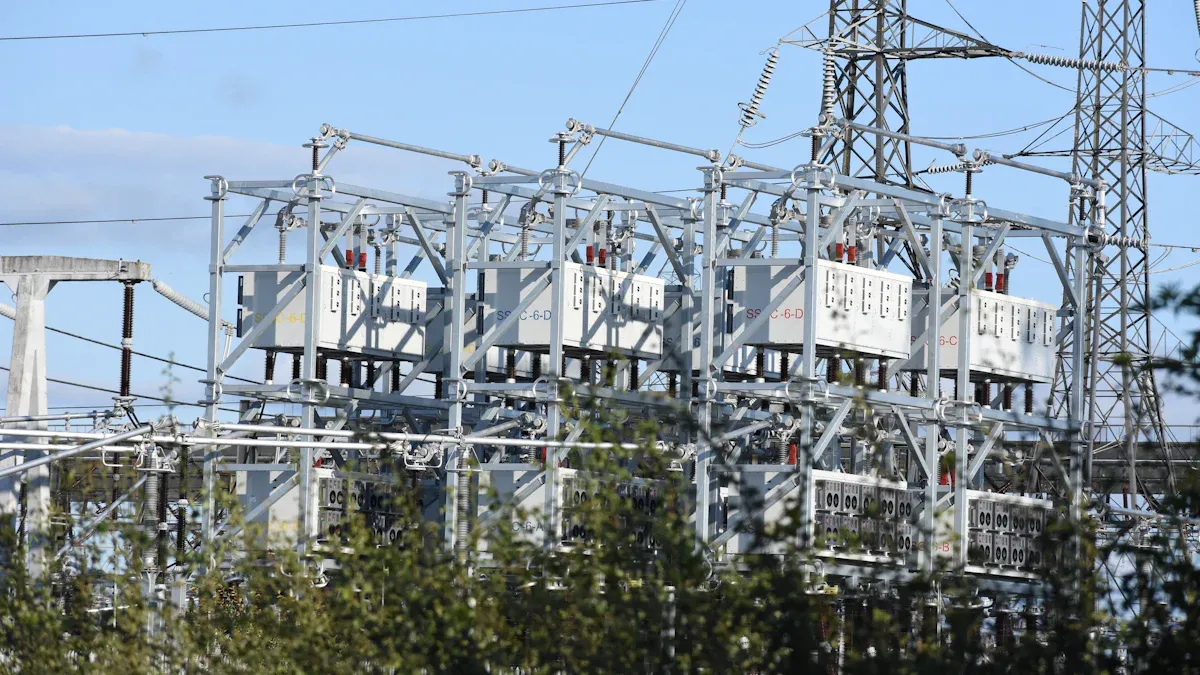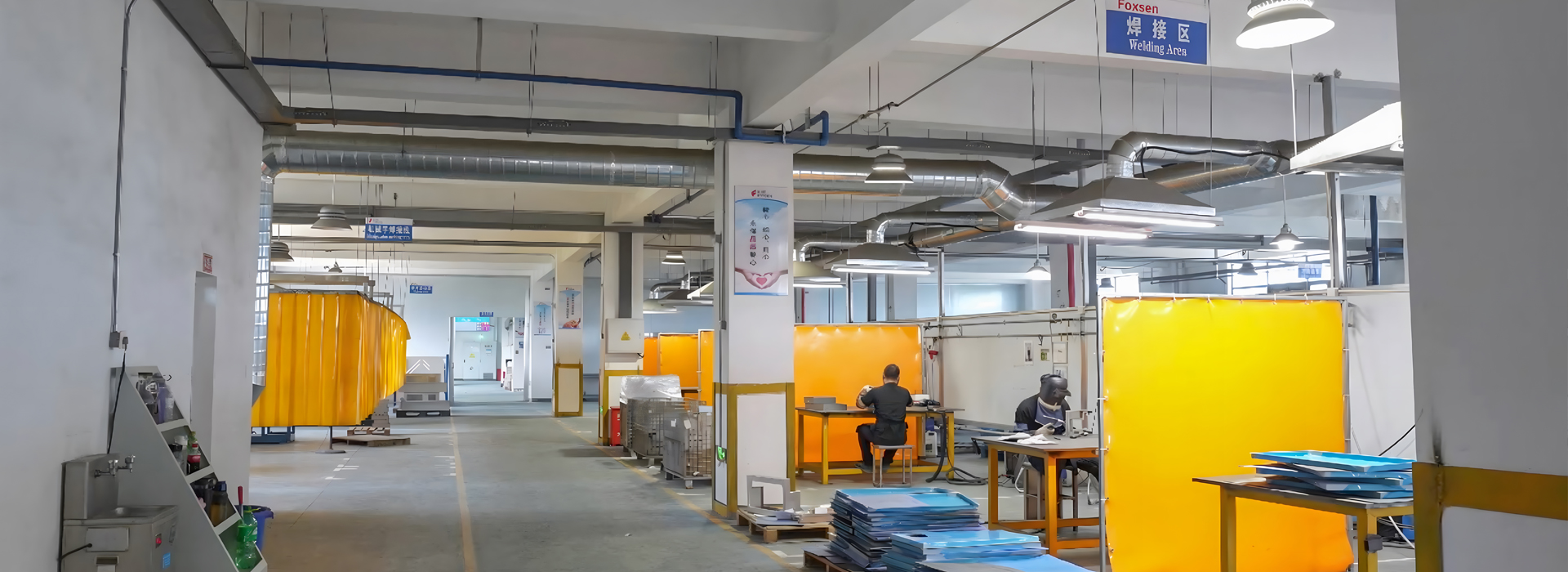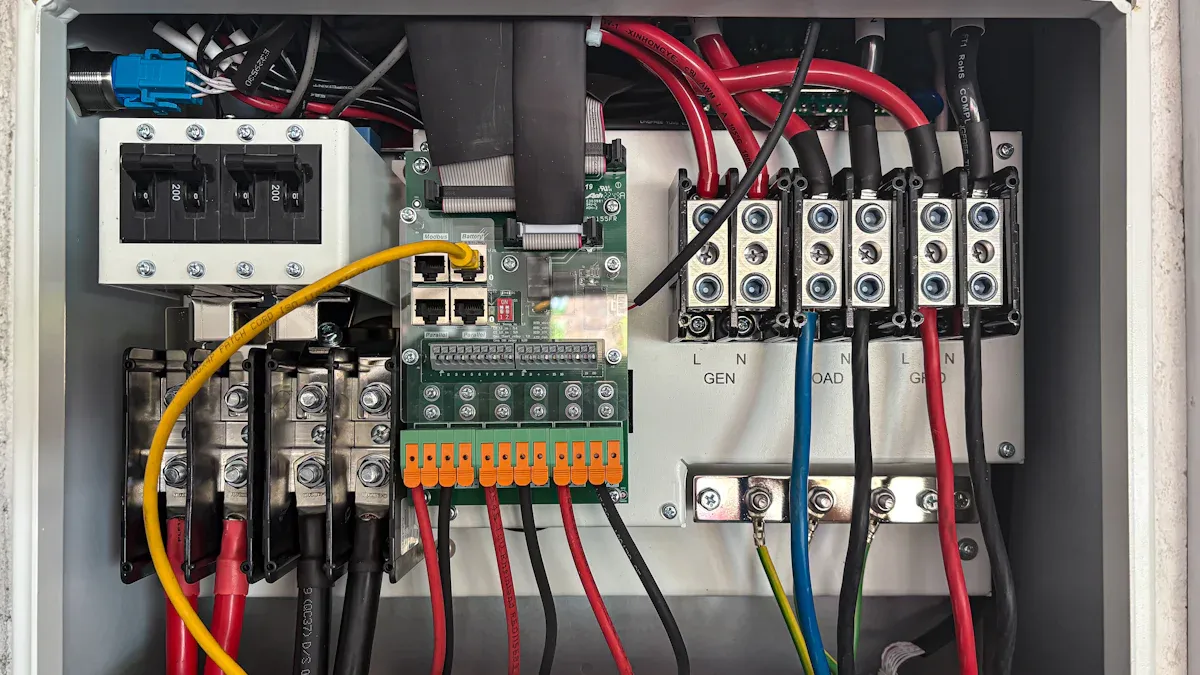Aluminum bus bars serve as essential components in electrical systems, designed to conduct and distribute power efficiently. These flat, rectangular bars made of aluminum are lightweight, durable, and highly conductive, making them a cost-effective choice for modern applications.
You’ll find them indispensable in sheet metal systems due to their ability to handle high electrical loads while reducing overall system weight. Consider these facts:
Aluminum bus bars are replacing copper in large-scale projects because of their lower cost.
Their lightweight nature cuts transportation and installation expenses, improving project efficiency.
Industries increasingly favor aluminum for its corrosion resistance, ensuring long-term reliability.
If you’re looking for a solution that balances performance, cost, and sustainability, a sheet metal Aluminum Bus Bar is the answer.
Key Takeaways
Aluminum bus bars are light and cheap, great for big projects.
They carry electricity well, saving energy and cutting costs.
Aluminum bus bars don’t rust, so they last a long time.
You can customize them to fit different needs and work better.
Using aluminum bus bars helps the planet since they recycle easily.
Understanding Sheet Metal Aluminum Bus Bars

Definition and Structure
A sheet metal aluminum bus bar is a metallic strip or bar designed to conduct electricity within power distribution systems. These components are commonly found in switchgear, panel boards, and other electrical setups. Their primary purpose is to connect high-voltage equipment and efficiently carry significant electrical currents. The material composition and cross-sectional size of the bus bar determine its current-carrying capacity, making aluminum a popular choice due to its lightweight and conductive properties.
Aluminum bus bars come in various shapes, such as flat strips, hollow tubes, and even custom designs tailored to specific applications. These shapes are not just for aesthetics—they enhance efficiency and cooling, ensuring optimal performance in demanding environments. For instance, flat strips are ideal for compact systems, while hollow tubes improve heat dissipation in high-load applications. This versatility makes aluminum bus bars a cornerstone of modern sheet metal systems.
A study on aluminum and copper joints highlights the mechanical strength of aluminum bus bars. It reveals that these joints can withstand a maximum load of 3.56 kN and a displacement of 9.30 mm, showcasing their reliability in applications like electric vehicle batteries.
Role in Electrical and Sheet Metal Systems
You might wonder why aluminum bus bars are so crucial in electrical and sheet metal systems. The answer lies in their ability to balance performance, cost, and sustainability. These bus bars act as the backbone of power distribution networks, ensuring electricity flows seamlessly between components. Their high conductivity minimizes energy loss, making them an efficient choice for both industrial and residential setups.
In sheet metal systems, aluminum bus bars offer additional benefits. Their lightweight nature reduces the overall weight of the system, simplifying installation and transportation. Moreover, their corrosion resistance ensures long-term durability, even in harsh environments. This makes them particularly valuable in renewable energy systems, where reliability and efficiency are paramount.
By choosing a sheet metal aluminum bus bar, you’re not just investing in a component—you’re opting for a solution that enhances system performance while reducing costs. Whether you’re designing an industrial power grid or a residential electrical panel, aluminum bus bars provide the reliability and efficiency you need.
Advantages of Sheet Metal Aluminum Bus Bars
Lightweight and Efficient
When you choose aluminum bus bars for your sheet metal systems, you unlock a world of efficiency. Aluminum’s lightweight nature makes it a game-changer in electrical applications. It weighs significantly less than copper, with a density of just 2.7 grams per cubic centimeter compared to copper’s 8.9 grams per cubic centimeter. This means aluminum bus bars can carry more load current per unit weight, making them ideal for high-performance systems.
Tip: Lightweight materials like aluminum reduce shipping and installation costs, saving you money and time on large-scale projects.
Here’s how aluminum bus bars outperform copper in key areas:
By opting for Foxsen sheet metal Aluminum Bus Bars, you’re not just choosing efficiency—you’re investing in sustainability and cost savings.
Cost-Effectiveness and Durability
Aluminum bus bars offer unmatched cost-effectiveness for your electrical systems. They are more affordable than copper, both in terms of material cost and installation expenses. Their lightweight design reduces transportation costs, while their natural corrosion resistance minimizes maintenance requirements.
Note: Aluminum bus bars are made from recycled materials, further lowering project costs and supporting eco-friendly initiatives.
Durability is another standout feature. Aluminum’s thermal conductivity ensures efficient heat dissipation, making it ideal for applications like data centers and renewable energy systems. Studies show that injection lap riveted hybrid bus bars maintain excellent electrical performance over time, even after exposure to corrosion.
Foxsen’s sheet metal Aluminum Bus Bars combine affordability with long-term reliability, making them the perfect choice for your projects.
High Conductivity and Corrosion Resistance
Aluminum bus bars excel in conductivity, ensuring efficient power distribution across your systems. Laboratory tests confirm that E99 aluminum bus bars achieve ultra-high electrical conductivity, with values exceeding 62% IACS. This performance surpasses conventional electrical-grade aluminum, making it a top choice for demanding applications.
Callout: High conductivity means less energy loss, translating to lower operational costs and improved system efficiency.
Corrosion resistance is another key advantage. Unlike copper, which tends to oxidize, aluminum naturally resists rust, ensuring long-term durability. This property makes aluminum bus bars ideal for outdoor and industrial setups where exposure to harsh conditions is inevitable.
Aluminum bus bars are lighter than copper, simplifying installation.
They are more cost-effective, especially for large-scale applications.
Their natural rust resistance ensures reliability in challenging environments.
Foxsen’s sheet metal Aluminum Bus Bars deliver high conductivity and corrosion resistance, ensuring your systems perform at their best for years to come.
Types of Sheet Metal Aluminum Bus Bars
Standard Bus Bars
Standard aluminum bus bars are the backbone of many electrical systems. These rigid, flat bars are designed to provide reliable power distribution in industrial, commercial, and residential setups. Their simplicity and efficiency make them a popular choice for applications where stability and durability are essential.
You’ll appreciate their technical advantages over other materials. Aluminum bus bars weigh significantly less than copper, making them easier to handle and install. Their cost-effectiveness ensures you can achieve high performance without breaking your budget.
Tip: Standard aluminum bus bars are ideal for projects requiring cost savings and lightweight materials. Their recyclability also supports sustainable practices, making them a smart choice for eco-conscious designs.
Flexible Bus Bars
Flexible aluminum bus bars bring adaptability to your electrical systems. These bus bars are crafted with layered or braided aluminum strips, allowing them to bend and twist without compromising performance. Their flexibility makes them perfect for applications where space constraints or dynamic movements are involved, such as electric vehicles or robotics.
You’ll find flexible bus bars invaluable in reducing stress on connections. Their ability to absorb vibrations and thermal expansion ensures long-term reliability. Unlike rigid bus bars, they adapt to changing conditions, minimizing wear and tear.
Callout: Flexible bus bars simplify installation in tight spaces and reduce maintenance costs by preventing connection failures.
Hybrid Bus Bars
Hybrid aluminum bus bars combine the best of both worlds. These innovative bus bars integrate aluminum with other materials, such as copper, to enhance conductivity and mechanical strength. They are designed for high-performance systems where efficiency and durability are paramount.
You’ll benefit from their ability to handle higher current loads while maintaining lightweight properties. Hybrid bus bars are particularly useful in renewable energy systems and data centers, where power density and cooling efficiency are critical.
Note: Hybrid bus bars offer a balanced solution for demanding applications, ensuring optimal performance without sacrificing cost-effectiveness.
By choosing the right type of aluminum bus bar, you can tailor your electrical systems to meet specific needs, whether it’s standard reliability, flexible adaptability, or hybrid efficiency.
Applications of Sheet Metal Aluminum Bus Bars

Power Distribution in Industrial Systems
Aluminum bus bars play a vital role in industrial power distribution systems. Their lightweight design and high conductivity make them ideal for large-scale projects where efficiency and cost savings are critical. You’ll find them indispensable in applications like switchgear, transformers, and panel boards, ensuring seamless electrical transmission across complex networks.
Industrial projects benefit from aluminum bus bars due to their environmental advantages. They require only 5% of the energy needed for copper production, significantly reducing the carbon footprint. Almost 75% of aluminum bus bars can be recycled, making them a sustainable choice for industries aiming to minimize waste.
Foxsen’s sheet metal Aluminum Bus Bars deliver unmatched reliability and efficiency, making them the preferred choice for industrial systems worldwide.
Use in Commercial and Residential Setups
Aluminum bus bars are transforming electrical systems in commercial and residential spaces. Their lightweight nature simplifies installation, while their cost-effectiveness makes them a practical choice for budget-conscious projects. You’ll see them in applications like office buildings, data centers, and even smart homes.
The rise of smart home technologies and off-grid solar systems has increased the demand for aluminum bus bars in residential setups. They enhance energy efficiency and streamline installations, ensuring your electrical systems operate smoothly. In commercial spaces, aluminum bus bars provide reliable power distribution, supporting critical operations in data centers and office buildings.
Residential Applications: Growing demand due to smart home technologies and off-grid solar systems.
Energy Efficiency: Aluminum bus bars simplify installations and improve energy efficiency.
Commercial Sector: Widely used in office buildings and data centers for reliable power distribution.
Foxsen’s aluminum bus bars offer the perfect balance of performance and affordability, ensuring your commercial and residential projects succeed.
Integration in Renewable Energy Systems
Renewable energy systems demand components that are efficient, reliable, and sustainable. Aluminum bus bars meet these requirements, making them a cornerstone of modern green energy initiatives. Their lightweight design reduces transportation costs, while their corrosion resistance ensures long-term durability in outdoor environments.
You’ll find aluminum bus bars integrated into solar panels, wind turbines, and other renewable energy systems. A notable example involves a renewable energy company that partnered with AP Precision to improve solar panel efficiency. By using custom aluminum bus bars, they enhanced green energy conversion rates and reduced environmental impact.
Aluminum bus bars facilitate integration with renewable energy sources.
They align with principles of reliability, efficiency, and sustainability.
Their use supports innovations that meet modern energy demands.
Foxsen’s sheet metal Aluminum Bus Bars empower renewable energy systems to achieve peak performance while promoting sustainability.
Customization and Manufacturing of Sheet Metal Aluminum Bus Bars
Tailoring for Specific Applications
Aluminum bus bars offer unmatched flexibility when it comes to customization. You can tailor them to meet the unique demands of your electrical systems, ensuring optimal performance and efficiency. Whether you need specific dimensions, enhanced load capacity, or lightweight designs, aluminum bus bars can adapt to your requirements.
For industries like electric vehicles, these tailored solutions ensure stable power supply and reduced energy losses. Laminated designs, for example, provide low inductance and high current capacity, making them ideal for high-frequency circuits.
Tip: Customizing your aluminum bus bars ensures they align perfectly with your system’s needs, reducing downtime and maximizing efficiency.
Advanced Manufacturing Techniques
Modern manufacturing techniques elevate the performance of aluminum bus bars. Processes like nickel plating enhance durability, corrosion resistance, and electrical conductivity. This ensures your bus bars perform reliably even in harsh environments.
Nickel plating offers several advantages:
Protects against environmental degradation.
Improves mechanical strength and wear resistance.
Enhances electrical contact reliability.
Facilitates secure soldering during assembly.
High-purity aluminum is another game-changer. It provides the necessary conductivity and reliability for demanding applications. Tailored designs and advanced fabrication methods optimize efficiency, ensuring your bus bars meet specific equipment needs.
Ensuring Quality and Performance
Quality control is critical in manufacturing aluminum bus bars. Rigorous testing ensures they meet industry standards and perform reliably over time. You can trust that every bus bar undergoes:
In-process testing to verify compliance.
Final inspections to confirm structural integrity.
Mechanical tests, including tensile and bending tests, to evaluate strength and flexibility.
These measures guarantee that your bus bars deliver consistent performance, even under challenging conditions. By choosing high-quality aluminum bus bars, you invest in a solution that combines durability, efficiency, and reliability.
Callout: Quality assurance processes ensure your aluminum bus bars are built to last, reducing maintenance costs and enhancing system longevity.
Comparing Sheet Metal Aluminum Bus Bars with Other Materials
Aluminum vs. Copper Bus Bars
When comparing aluminum and copper bus bars, you’ll notice distinct differences in their properties. Aluminum offers a lightweight alternative, weighing only about one-third as much as copper. This makes it easier to handle and install, especially in large-scale projects. While copper boasts superior electrical conductivity, aluminum compensates with its cost-effectiveness and corrosion resistance.
Aluminum’s natural oxide layer protects it from rust, making it ideal for outdoor and industrial environments. Copper, while more conductive, is heavier and significantly more expensive. For projects where weight and budget are critical, aluminum bus bars emerge as the smarter choice.
Performance and Cost Analysis
Aluminum bus bars deliver impressive performance at a fraction of the cost of copper. Although aluminum’s resistivity (2.82 μΩ-cm) is higher than copper’s (1.72 μΩ-cm), you can adjust the size of aluminum bus bars to achieve comparable current-carrying capacity.
Copper-clad aluminum bus bars offer a middle ground, maintaining 92% of copper’s conductivity while reducing costs by 38%. This makes them a compelling option for high-frequency applications. For budget-conscious projects, aluminum bus bars remain the most cost-effective solution.
Adaptability and Environmental Impact
Aluminum bus bars shine in adaptability and sustainability. Their lightweight design simplifies integration into renewable energy systems, electric vehicles, and large-scale power grids. Unlike copper, aluminum is highly recyclable, aligning with eco-friendly initiatives.
Aluminum bus bars are more recyclable, reducing waste.
Companies aiming to lower their carbon footprint often choose aluminum.
Aluminum supports sustainability goals without compromising performance.
By choosing aluminum, you’re not just optimizing your system—you’re contributing to a greener future. Its adaptability and environmental benefits make it the material of choice for modern, sustainable projects.
Aluminum bus bars offer unmatched benefits for your electrical systems. Their lightweight design reduces costs and simplifies installation. Their high conductivity ensures efficient power distribution, while corrosion resistance guarantees long-term reliability. You can use them in industrial setups, renewable energy systems, and even smart homes.
Callout: Choosing aluminum bus bars means investing in sustainability, efficiency, and cost savings.
Their importance in modern sheet metal systems continues to grow. By adopting aluminum bus bars, you align your projects with cutting-edge technology and eco-friendly practices.
FAQ
What makes aluminum bus bars better than copper for large-scale projects?
Aluminum bus bars weigh less and cost less than copper. Their lightweight design reduces transportation and installation expenses. They also resist corrosion, ensuring long-term reliability. For large-scale projects, these benefits make aluminum the smarter, more economical choice.
Can aluminum bus bars handle high electrical loads?
Yes, aluminum bus bars can handle significant electrical loads. Their high conductivity ensures efficient power distribution. By adjusting the size of the bus bar, you can achieve the same current-carrying capacity as copper, making them suitable for demanding applications.
Are aluminum bus bars environmentally friendly?
Absolutely! Aluminum bus bars are highly recyclable, with up to 75% of their material being reusable. Their production requires less energy compared to copper, reducing the overall carbon footprint. Choosing aluminum supports eco-friendly initiatives and promotes sustainability.
Where can I use aluminum bus bars?
You can use aluminum bus bars in industrial, commercial, and residential systems. They are ideal for renewable energy setups, electric vehicles, and data centers. Their versatility and efficiency make them suitable for a wide range of applications.
How do I ensure the quality of aluminum bus bars?
Choose bus bars from reputable manufacturers. Look for products that undergo rigorous testing, including mechanical and electrical performance evaluations. High-quality aluminum bus bars ensure durability, efficiency, and long-term reliability in your systems.






